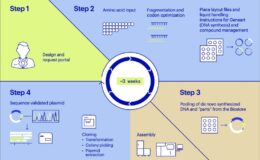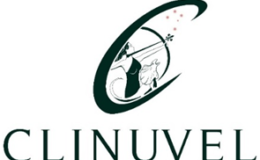
Christopher Carr couldn’t see the wood he was supposed to be walking on. The ad-hoc boardwalk running through this part of British Columbia had sunk beneath a quicksand-like mud. He proceeded slowly, each step a piece of guesswork.
The path, through a super-salty lake near a town called Clinton, had a prize at the end, though: spots where the MIT astrobiologist, hopefully, could find evidence of strange life. In environments like this, which may resemble long-gone lakes on Mars, the salt preserves fingerprints of biology like it preserves bacon. Astrobiologists like Carr—and Georgetown’s Alexandra Pontefract, who’s in charge of these field trips—have been able to find evidence of microbial communities that consume sulfate and don’t need oxygen.
This trip, in late 2018, wasn’t Carr’s first outdoor adventure. He’s trekked to a polar desert, old mines that seep acid, and an active volcano. Pontefract traveled back to the hypersaline lakes in interior British Columbia this September to gather some more samples—ramming sediment corers into the salty lake bottoms, setting up gas samplers, and toting samples back to the lab for analysis.
Collecting squirmers—and signs of their ancestors—is key to Carr’s work, in particular to another program called SETG, the Search for Extraterrestrial Genomes. The research team, based at MIT, centers on the idea that life on Earth and life on Mars (if it exists) might be related. Carr and his group are developing autonomous tools that could someday travel to Mars, collect samples, extract their genetic material, and sequence it—no humans required.
That’s why Carr goes on extreme field trips: to practice getting, detecting, and characterizing the organisms in Earth’s most inhospitable places, so that someday his instruments will be ready for the real deal.
In that quest, SETG has sought technology from outside academia, with project funding that comes primarily from a NASA astrobiology program called MatISSE, the Maturation of Instruments for Solar System Exploration. (The MIT Media Lab, which has recently come under fire for taking money from Jeffrey Epstein, provided one microgravity flight at no cost to the project.) SETG is also collaborating with two companies in the biotech industry—because while astrobiologists may be smart cookies, they aren’t the ones who build next-generation gene sequencers.
Carr’s industrial collaborations, not the norm for NASA’s astrobiology research, may help change the agency’s interactions with the commercial life-sciences world. Maybe, in the future, NASA will buy space-gene auto-sequencers the same way it would buy a rocket launch from SpaceX.
Cross-planetary platforms
Key words: “In the future.” Such an instrument doesn’t exist for Earth yet, let alone for space. But SETG, founded by Harvard geneticist Gary Ruvkun and MIT planetary scientist Maria Zuber in 2005, is making progress. Its current prototype integrates technology from two companies: Claremont BioSolutions and Oxford Nanopore Technologies. Right now, the researchers are assembling it into final form, which they’ll test next year in the Chilean desert. If it proves itself worthy, SETG will then be ready to apply for an interplanetary mission, with Claremont and Oxford aboard.
Neither biotechnology company is a stranger to microgravity: Both Oxford and Claremont’s products have spent time on the International Space Station, used in projects like WetLab-2, the Biomolecule Sequencer, and Genes-in-Space-3.
Claremont makes PureLyse, a kit that includes a battery-powered cell-splitter and the solutions needed to break cells into their constituent parts and extract their DNA and RNA. In a typical lab, those processes require a spinning centrifuge and a human to run the machine; Claremont’s solution eliminates the former and barely requires supervision. “Our goal is to have the user only need to load their sample into the cartridge, and then hit the ‘Go!’ button,” says Claremont president Robert Doebler, and then remove the tube with DNA after 10 to 15 minutes. On another planet, you’d just need some robotics to do the loading, button-pressing, and removal (easy!).

Christopher Carr
Oxford makes the analytic backbone of SETG: a sequencer called MinION, which reads out the ordered base pairs fed into the machine. The device has already been used to do same-day genomic analysis of cancer cells, to analyze the microbes in glaciers, and to simultaneously sequence multiple RNA viruses in real time. The instrument is small, self-sufficient, and cheap(ish).
The sequencer contains a single sensor chip, which contains a membrane embedded with a bunch of nanopores—a fancy name for tiny holes. The device runs a voltage across the membrane, and current flows through the pores. Strands of genetic material, themselves electrically charged, can pass through the pores with the current. “As they go through, we can measure the resistance,” says Oxford’s chief technology officer Clive Brown. That resistance differs for different base sequences, and software matches it up with the corresponding chain of molecules.
The process definitely works for terrestrial DNA. But would it translate to the genetic scaffolding of possible Martian life, which—even if it were related to life here—would have spent billions of years on a different evolutionary track? What if it’s built out of not DNA or RNA but a hypothetical XNA?
“In principle, you could use Oxford’s technology,” says Carr. “If it could go through a nanopore, it could possibly be detected.” The SETG team has already used the sequencer and software called CarrierSeq to detect ionosine, a nonstandard base you won’t find inside yourself.
This Claremont/Oxford setup—SETG’s most evolved instrument—isn’t what Carr has always taken into the field, to places like British Columbia’s salty, sulfurous lakes, trips currently led by MIT’s Alexandra Pontefract. But in earlier trips to lakes like these, researchers have been able to find a diverse community of organisms squirming around in the water. For instance, in Spotted Lake, SETG and collaborators uncovered microbes of the genus Desulfotignum, which don’t ingest oxygen but can turn either organic or inorganic compounds into energy; of a class called Mollicutes, parasites without cell walls; and Haloplasmatales, which can only live in oversalted places.
“Testing in these analog environments,” says Carr, where the chemistry and (or) mineralogy resemble those one might find on planets that are not Earth, “allows us to validate methods of isolating genetic material.” That’s why SETG’s upcoming prototype has to go out into the field, too.
Disrupting the space space
While development isn’t done, the SETG instrument is nearing completion. “We’re taking the pieces and putting them together,” says Carr. The team is planning to take the real deal to the Atacama desert in Chile in April 2020—the final proof of concept required before NASA sees the team as ready for a real space mission, with industry along for the ride.
It’s one small step toward a new way NASA could do its biology business. The agency could treat biotech like it does launches. With the Commercial Crew and Cargo programs, the agency buys a rocket launch direct from a company, rather than building its own vehicle and then sending it to space.
Bedding down with industry isn’t the typical NASA astrobiology way. The agency does have Small Business Innovation Research and Small Business Technology Transfer programs, and some of their funds have gone to astrobiology-relevant stuff. But most of the astrobiology program’s money goes to individual researchers and university groups, like SETG. Its support to companies is usually more indirect. “We’ve funded research that’s gone on to become part of a commercial enterprise,” says Lindsay Hays, the division’s deputy program scientist. “We’ve funded the kernel of it.”
NASA, she says, is not ready to shift to a direct-purchase model. And neither is the actual biotechnology. “We certainly are not at a place yet where we are just going to be able to buy The Simple Life Detector Instrument and send it to the next moon we find,” she says.
But Aaron Burton, a planetary scientist who’s not a member of SETG but is familiar with its work, sees big benefits to using already-extant biotech in space. He’s seen them himself, as principal investigator and co-investigator, respectively, for NASA’s BioMolecule Sequencer and Genes-in-Space-3 projects. For one, industry does R&D faster than NASA. “We’re not very efficient at building new things,” he says. “Things that we’ve done previously, we can redo pretty well. But we put a lot of requirements on things, and we’re not always good at acting quickly.”
Plus, it’s expensive to build tech from scratch. “The sequencing tech has benefited from billions of dollars of investment,” says Burton. “There’s no way NASA could afford or pay for that.”
Private investment in Oxford alone, says Carr, far exceeds NASA’s annual astrobiology budget.
And the biotech industry, or at least the two companies collaborating with SETG, has jumped on the ship. Oxford’s Brown says he offered, at a recent astrobiology meeting, to build a MinION sequencer just for space, based on features space-types want.
Why? Space may not be the biggest market, but it does have the cool factor. And, says Doebler, it demonstrates the range of the products—shows they work in even extreme circumstances. “[Carr]’s soils are the most difficult that we’ve had to deal with,” he says. “It’s a good showcase of our technology.”
Maybe, someday not too long from now, SETG will find earthlings’ ancient cousins in the alien red dirt. Maybe probably not. But, says Carr, “it seems likely enough that we ought to check.”
Plus, if they find biology way out there, a new market could materialize. “Will detecting alien lives open up a huge commercialization opportunity?” says Burton. “I don’t know.” It seems likely enough that somebody ought to check.














